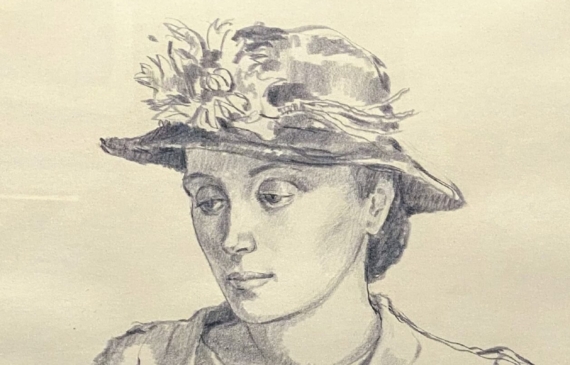Andrée Ruellan

Andrée Ruellan
American, 1905 – 2006
Young Woman, Carlotta Petrina
Pencil on paper
11 H. x 9 W. inches
Signed lower right: Andrée Ruellan
Artist Description
American artist Andrée Ruellan was born in 1905, in a brownstone near Washington Square Park in New York City. She was the only child of a couple who had recently immigrated from France. Her socialist parents encouraged her artistic interest from an early age, believing the arts could help Americans empathize with the less fortunate. When Ruellan was eight years old, they hired amateur artist Ben Liber to mentor her, and in 1914, the socialist monthly The Masses published one of her drawings, April, depicting an angel flying through the air, scattering flowers over a workman’s head. She attracted the attention of painter Robert Henri of the Ashcan School, who included some of her drawings and watercolors in an exhibition at St. Mark’s Church-in-the-Bowery in which he also showed.
After her father died in a work accident, Ruellan sold paintings, watercolors, and drawings to support herself and her mother. In 1920, she earned a scholarship to study at the Art Students League with painter Maurice Stern and sculptor Leo Lentelli. She went with Stern to Rome in 1922 on another scholarship and afterwards stayed in Paris with her mother for five years to continue her studies. She had her first solo exhibition at the Sacre du Printemps Galerie during this period, and in 1928 had her second solo show at the Weyhe Gallery in New York. She met and married American artist John Taylor in Paris, and Taylor, Ruellan, and her mother moved back to America in 1929, settling in Shady, a village near Woodstock, New York, where they were based for the rest of their lives.
Ruellan’s signature style, which she developed over the course of the 1930s, has been described as social-realist, with elements of modernism and abstraction. She conveys the warmth, humanity, and depth of emotion of her subjects in order to evoke the viewer’s sympathy. It was important to Ruellan that she portrayed each subject as an individual, not just a generic “type”, and captured their nuances. In the early 40s, she and Taylor traveled across the southeastern U.S. to destinations such as Charleston and Savannah, as well as smaller towns such as Emporia, Virginia and Lawrenceville, Georgia, to find the down-to-earth subjects that they preferred. Ruellan liked to sketch on site during this period and would return home to complete her oil paintings. She always strove to retain the informality of the moment that she was capturing.
Ruellan sought to defy categorization, switching her representation from the Maynard Walker Galleries to the Kraushaar Galleries in 1941 because the Walker Galleries were known for showing American Scene painters. She did not want to be confined to a genre of art, insisting that her subjects were not representative of any group, be it a class, race, or geographic region.
During and after World War II, Ruellan’s style shifted towards surrealism, favoring darker themes that portray greater tension. Her subjects during this period were often children in playful yet disturbing poses and settings. In the mid-1950s, her work evolved to become brighter and more abstract. She experimented with the Chinese sumi ink wash style of painting and created pieces reminiscent of Abstract Expressionism. Ruellan and Taylor participated in the artists’ colony of Woodstock over the next several decades, and she continued to create art well into her eighties.

